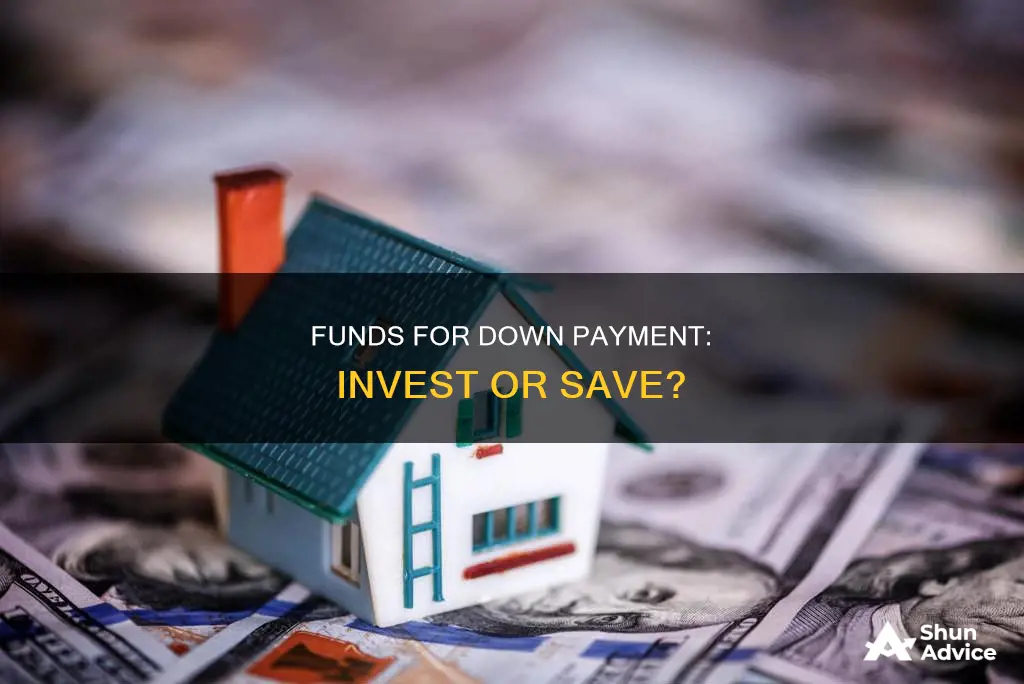
Saving for a down payment on a house is a major financial goal for many people. However, it is important to consider the risks and potential returns involved in different investment options.
If you plan to buy a house imminently, it is generally recommended to keep your down payment savings in cash or a high-yield savings account. This ensures that your money is readily available and protected, although it may earn a lower return compared to other investments.
For those with a longer time horizon, investing in low-risk options like US Treasuries or a diversified portfolio of low-cost index funds could potentially provide higher returns. However, it is important to consider your risk tolerance and the potential impact of market volatility on your savings.
Additionally, there are other factors to consider, such as your financial situation, credit score, and the availability of first-time homebuyer assistance programs. It is always a good idea to consult with a financial professional to determine the best savings and investment strategy for your specific circumstances.
| Characteristics | Values |
|---|---|
| Time until buying a house | The closer you are to buying a house, the less risk you should take with your down payment |
| Risk tolerance | The lower your risk tolerance, the lower risk you should take with your down payment |
| Investing acumen | The better your investing acumen, the more risk you are able to take with your down payment |
| Existing cash balance | The higher your existing cash balance, the more risk you can take with your down payment |
| Cash flow | The higher your cash flow, the more risk you can take with your down payment |
| Mortgage interest rate | The higher the mortgage interest rate, the bigger the down payment you should make |
| Outlook on mortgage rates | The higher you expect mortgage rates to go, the pickier you should be with your down payment |
| Outlook on financial future | The more bullish you are about your financial future, the more leverage you may take with your down payment |
| Liquidity | Investments should be made in investments that can become liquid by the time you want to purchase |
| House affordability | The total house value should generally be no more than 3 to 5 times your total annual household income |
| Down payment percentage | The exact percentage depends on your lender and credit |
| Private mortgage insurance | If you don't put down 20% or more, you may have to take on private mortgage insurance |
| Time until saving for a down payment | Your timeline might influence which savings tools to consider |
| Investment returns | The longer until a purchase date, the more risk you may feel comfortable taking on |
What You'll Learn

How much money do I need to save for a house?
Saving for a house can be a daunting task, but with a clear plan and the right tools, it is achievable. Here are some tips to help you determine how much money you need to save for your dream home:
Determine Your Down Payment:
A good rule of thumb for your down payment is 20% of the sale price. This will help you avoid paying private mortgage insurance (PMI), which is typically required if you put less than 20% down. However, if you are a first-time homebuyer, a down payment of 5-10% may be acceptable, but you should be prepared to pay for PMI. It is important to note that a larger down payment also means smaller monthly payments and less debt.
Calculate Closing Costs:
Closing costs typically range from 2-5% of the home's purchase price and include various fees such as homeowners insurance, property taxes, loan origination fees, attorney fees, and underwriting fees. These costs are paid at the time of closing, so it is crucial to budget for them in addition to your down payment.
Consider Moving and Other Expenses:
Don't forget to factor in the cost of moving, which can range from $900 to $2,500 depending on the distance and the size of your home. You may also need to budget for repairs, renovations, new furniture, and ongoing homeownership costs such as utility bills, homeowners association (HOA) fees, and maintenance.
Save for a Comfortable Monthly Payment:
Use a mortgage calculator to determine how much your monthly payments will be based on the purchase price of the home, your down payment, and the interest rate. As a general guideline, your monthly mortgage payment, including taxes and insurance, should not exceed 25% or 28% of your take-home pay. This will ensure that you have enough money left in your budget for other financial goals, such as saving for retirement.
Start Saving Early:
The sooner you start saving, the sooner you can make your dream of homeownership a reality. Consider setting up a separate savings account specifically for your down payment and take advantage of high-yield savings accounts or money market accounts to boost your savings. Automating your savings by having a portion of your paycheck directly deposited into your savings account can also help you stay on track.
Remember that the amount of money you need to save depends on various factors, including the cost of the home, your income, and your financial situation. It is always a good idea to consult with a financial advisor or mortgage broker to determine how much house you can comfortably afford and to create a savings plan that is tailored to your individual circumstances.
Mutual Funds Philippines: Best Time to Invest
You may want to see also

What are the best savings accounts for a house down payment?
When saving for a house down payment, it is best to avoid putting your money in an investment account, like a brokerage account or mutual fund. Instead, opt for a high-yield savings account, money market account, or certificate of deposit (CD). These options will allow you to earn interest on your savings while keeping your money safe and accessible. Here are some of the best savings accounts for a house down payment:
- UFB Direct Money Market Savings Account: This account offers a competitive interest rate and check-writing capabilities, as well as a Visa debit card for added convenience. While it has a $10 monthly fee, this can be waived by maintaining a $5,000 daily balance.
- CIT Bank Platinum Savings Account: This account offers one of the best interest rates in the industry, with no monthly fee or minimum balance requirements. The high rate applies to the first $100,000, so you can earn a substantial amount of interest.
- Synchrony Bank High Yield Savings Account: Synchrony Bank provides a competitive savings rate with no monthly fee or minimum balance requirement. They also offer an optional ATM card for emergency cash withdrawals and a perks program with benefits like ATM fee reimbursements and free wire transfers.
When choosing a savings account for your house down payment, look for accounts with competitive interest rates, easy account accessibility, and no monthly fees. Automating your savings and putting windfalls and extra cash into this account will help you reach your goal faster. Remember to keep your savings separate from your other accounts to avoid the temptation of spending this money elsewhere.
Setting Up an Investment Fund: Hong Kong Guide
You may want to see also

How can I save money for a house down payment?
Saving for a house down payment can be a challenging but rewarding endeavour. Here are some strategies to help you save effectively:
Assess Your Financial Situation
Understanding your current financial position is crucial. Evaluate your income, expenses, and debt to determine how much house you can afford and the associated down payment and closing costs. Check your credit score and ensure your debt-to-income ratio is within acceptable limits.
Set Clear Savings Goals
The 28/36 rule suggests that your maximum monthly mortgage payment should not exceed 28% of your gross monthly income, while your total monthly debt payments should not be more than 36%. Calculate these values to determine your budget and the required down payment. Remember to consider additional costs such as taxes, insurance, maintenance, and repairs when setting your budget.
Develop a Savings Plan
Consider setting up a separate savings account dedicated to your down payment. Automate your savings by setting up direct deposits or automatic transfers to this account. Explore high-yield savings accounts, money market accounts, or certificates of deposit (CDs) to boost your savings with higher interest rates.
Cut Back on Expenses
Reducing expenses can significantly contribute to your savings goal. Identify areas where you can cut back, such as dining out, entertainment, subscriptions, or travel. Negotiate discounts or lower rates on recurring expenses like insurance, cable, internet, or cellphone plans.
Increase Your Income
Boosting your income will accelerate your savings. Consider taking on a side hustle, starting a small business, or selling items you no longer need. Look for opportunities to increase your income at your current job or explore higher-paying positions elsewhere.
Explore Down Payment Assistance Programs
Down payment assistance programs can provide financial support, especially for first-time homebuyers. Research options at the city, county, state, and federal levels, including lender-specific programs and incentives offered by rent-to-own or new construction developers.
Save Windfalls and Extra Income
Commit to allocating windfalls and extra income towards your savings goal. This includes tax refunds, bonuses, or unexpected sources of cash. Send these funds directly to your savings account and include them in your monthly budget.
Monitor and Adjust Your Savings Plan
Regularly review your progress and make adjustments as needed. Stay motivated by visually tracking your savings progress and celebrating milestones. Remember that setbacks may occur, but staying focused and disciplined will help you achieve your goal.
A Beginner's Guide to Index Funds in Singapore
You may want to see also

How long does it take to save for a house down payment?
The time it takes to save for a house down payment depends on a variety of factors, including income, home prices, savings rate, and the desired down payment amount. Let's break down each of these factors and discuss how they impact the timeline for saving.
Income and Home Prices:
The higher your income, the faster you can save for a down payment, assuming your expenses remain relatively stable. However, it's important to note that areas with higher incomes often have higher home prices as well, which can offset the advantage of higher earnings. For example, in San Francisco, where the median household income is $126,187, it would take about 10.5 years to save a 20% down payment for a median-priced home costing $1.325 million. In contrast, in Detroit, where the median household income is $34,762, it would take just two and a half years to save a down payment for a median-priced home costing $88,900.
Savings Rate:
The amount you can save each month towards your down payment goal plays a crucial role in determining how long it will take to reach that goal. Financial experts generally recommend saving at least 10% of your income each month for a down payment. However, if you can save a higher percentage, you'll reach your target faster. For example, if you save $400 a month, it will take 15 months to save a 3% down payment on a $200,000 home, but it will take 100 months (over eight years) to save a 20% down payment on the same home.
Down Payment Amount:
The standard down payment amount is typically considered to be 20% of the home's purchase price. However, this is not a requirement, and many loan options are available that allow for a lower down payment. For example, conventional loans can be obtained with as little as 3% down, FHA loans with 3.5% down, and VA or USDA loans with 0% down. Opting for a lower down payment can significantly reduce the time needed to save. Using the previous example, saving a 3% down payment on a $200,000 home at a rate of $400 per month would take just 15 months, compared to 100 months for a 20% down payment.
Strategies to Save Faster:
- Cut back on expenses: Reducing discretionary spending, such as dining out, entertainment, and travel, can free up more money for your down payment fund.
- Increase your income: Consider taking on side hustles, asking for a raise, or changing jobs for a higher-paying position to boost your savings rate.
- Explore down payment assistance programs: There are various down payment assistance programs available, especially for first-time homebuyers. These programs can provide financial support and reduce the amount you need to save.
- Automate your savings: Set up automatic transfers from your paycheck or bank account to your savings account to make saving effortless and ensure you stay on track.
- Choose the right savings account: Opt for a high-yield savings account or money market account to earn higher interest rates on your savings and reach your goal faster.
Monthly Mutual Fund Investment: A Step-by-Step Guide
You may want to see also

What are the risks of investing my house down payment?
Investing your house down payment comes with a certain level of risk. The closer you are to buying a house, the less risk you should take. If you are planning on buying a house within the next 12-24 months, it is recommended that you invest your down payment more conservatively. This means limiting your stock exposure and opting for more secure options such as a high-yield savings account, money market fund, or short-term treasury bonds.
If you are more than five years away from buying a house, you can invest your down payment more aggressively. This means you can allocate a larger portion of your down payment to stocks or even invest in a private real estate fund.
- Market volatility: The stock market can be volatile, and there is a risk of potential losses, especially in the short term. If you invest your down payment in stocks and the market declines, you may end up with a smaller down payment than planned.
- Interest rate risk: Investing in bonds comes with interest rate risk. If interest rates rise, the price of the bond will decrease. This means that if you need to sell your bonds before maturity, you may lose some principal.
- Credit risk: Investing in bonds also carries credit risk. While US Treasuries are considered among the safest investments, there is still a potential for loss of principal if the credit rating of the US government changes.
- Liquidity risk: It is important to invest in assets that can be easily converted to cash when you need to make the down payment for the house. Avoid investing in illiquid assets that may be difficult to sell quickly.
- Opportunity cost: Keeping your down payment in cash may seem like the safest option, but it may result in opportunity costs. Cash is unlikely to earn enough interest to keep up with inflation, and you could miss out on potential returns by not investing your down payment.
- Default risk: If you take out a loan, such as a HELOC, to fund your down payment, you risk foreclosure if you are unable to keep up with the loan payments.
- Group investing risks: Group investing, or pooling funds with family and friends to buy a property, can be risky. Mixing money and friendship can become a disaster if the deal doesn't go as planned.
- Income and property tax: Investing in a rental property will increase the complexity of your tax situation. You will need to navigate property taxes and higher income taxes resulting from rental income.
It is important to carefully consider these risks and consult with a financial advisor before investing your house down payment.
A Guide to Mutual Fund Investing with Little Capital
You may want to see also
Frequently asked questions
The amount of money you need to buy a house depends on several factors, including the price of the home, the amount of your down payment, and your mortgage rate. You can use an online calculator to determine how much money you'll need based on these factors.
It depends on your risk tolerance and time horizon. If you're buying a house soon, it's generally recommended to invest your down payment in low-risk assets like US Treasuries or money market funds. If you're buying a house in 5+ years, you may want to invest in a diversified portfolio of stocks and bonds.
There are several options for investing your savings for a down payment, including high-yield savings accounts, money market funds, certificates of deposit (CDs), and US Treasuries. The best option for you depends on your risk tolerance, time horizon, and expected returns.







